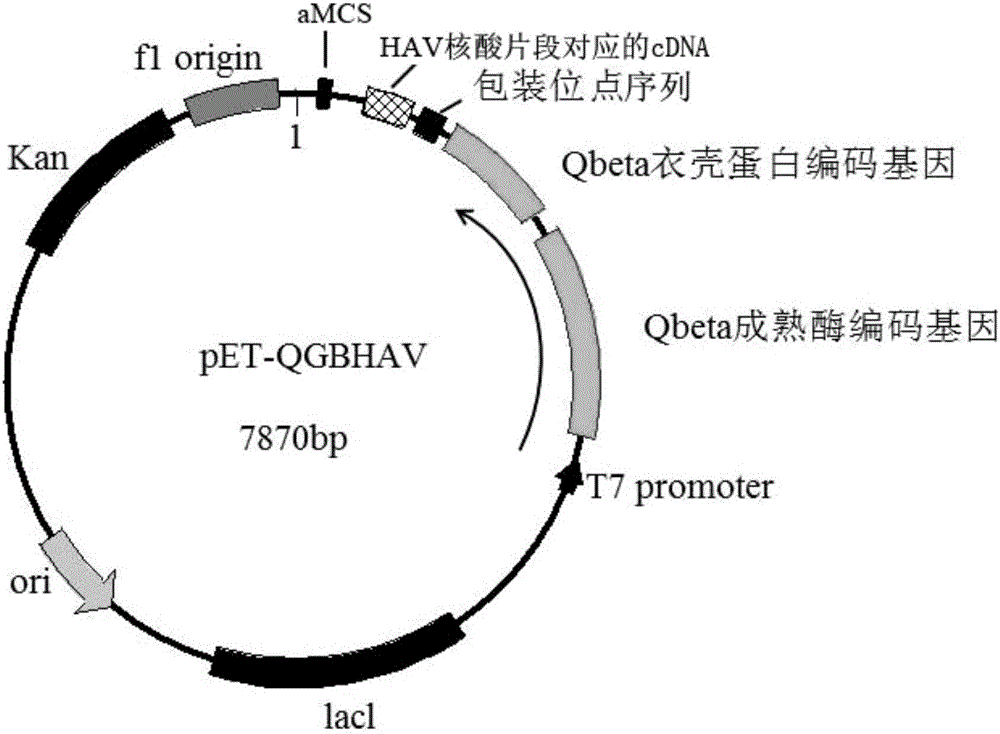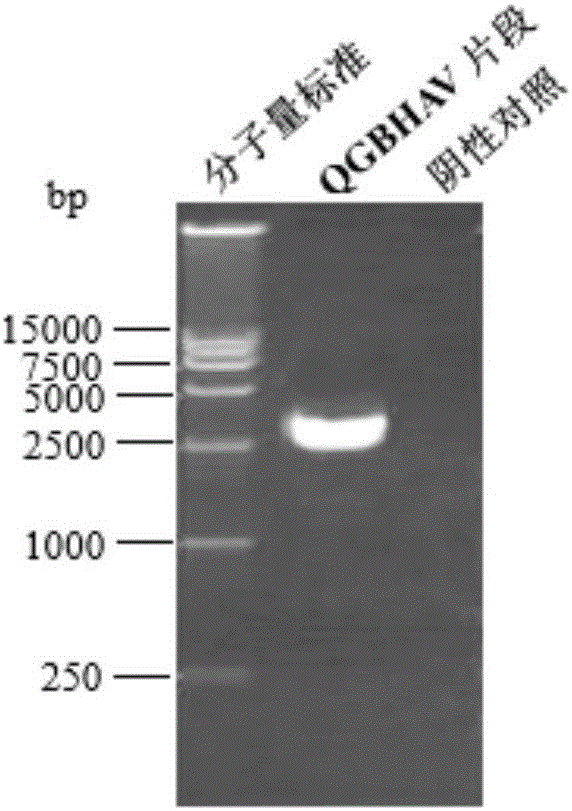Pseudovirus particle comprising hepatitis-A-virus nucleic acid fragment and preparation method of pseudovirus particle
A hepatitis A virus and pseudovirion technology, applied in the biological field, can solve the problems of inability to evaluate virus particle extraction and RNA reverse transcription detection steps, inability to evaluate virus particle extraction, affecting nucleic acid extraction, etc., and achieve non-infectious, Lower production cost and better stability
- Summary
- Abstract
- Description
- Claims
- Application Information
AI Technical Summary
Problems solved by technology
Method used
Image
Examples
Embodiment 1
[0031] Example 1: Construction of plasmid vector pET-QGBHAV
[0032] First, with reference to the Qbeta phage genome sequence (accession number is AB 971354) in the Genbank database and the HAV detection target sequence stipulated in the national standard GB / T 22287-2008, prepare the Qbeta phage maturation enzyme coding gene, DNA fragments including capsid protein coding genes, packaging site sequences, cDNA sequences corresponding to HAV nucleic acid fragments and auxiliary multiple cloning sites (hereinafter referred to as QGBHAV fragments) (see figure 1 ), the DNA fragment has the sequence shown in SEQ ID No.1 in the sequence listing. Auxiliary multiple cloning sites include, for example, Apa I, KpnI, Pst I, Spe I, Sph I, and Not I from the 5' end to the 3' end. The above DNA fragment was subcloned into the pUC-18 vector to obtain an intermediate plasmid vector, which was named pUC-QGBHAV.
[0033] Next, PCR amplification was performed using the intermediate plasmid vec...
Embodiment 2
[0045] Embodiment 2: the preparation of pseudovirus particle
[0046] Transform the plasmid vector pET-QGBHAV prepared in Example 1 into, for example, Escherichia coli BL21 competent cells, and then spread it on a nutrient agar plate containing kanamycin (final concentration: 50 μg / mL), and culture at 37°C for 18h . The specific preparation method of nutrient agar plate is as follows: Tryptone 1g, NaCl 0.5g, yeast extract 0.5g, agar powder 1.5g, dissolved in 90mL ddH 2 In O, adjust the pH value to 7.0-7.2, add ddH 2 O was adjusted to 100mL, autoclaved for later use.
[0047] Then, a single colony spot was picked from the cultured plate above, and inoculated in 3 mL of liquid LB medium containing kanamycin (final concentration: 50 μg / mL), and cultured at 37° C. for 18 h. The specific preparation method of liquid LB medium is: tryptone 1g, NaCl 0.5g, yeast extract 0.5g, dissolved in 90mL ddH 2 In O, adjust the pH value to 7.0-7.2, add ddH 2 O was adjusted to 100mL, autocl...
Embodiment 3
[0055] Embodiment 3: the detection of residual plasmid DNA in pseudovirion
[0056] Detect whether the pseudovirus particles prepared in Example 2 contain residual nucleic acid fragments of the plasmid pET-QGBHAV by PCR amplification method, design the upstream primer PpqGHAVF and the downstream primer PpqGHAVR, the sequences are as shown in Table 4, and the pair of primers can amplify the plasmid pET -A target region of about 134bp upstream and downstream of the hepatitis A virus target cDNA fragment contained in QGBHAV. The positive control was set up with the plasmid vector pET-QGBHAV as the template, and the ddH 2 O sets a negative control for the template. The reaction system is shown in Table 5.
[0057] Table 4
[0058] Primer
sequence
PPML
5'-CAGCATAAGCTTTTTCCGGAG-3'
PpqGHAVR
5'-GCGGCCGCTCTAGAGCAC-3'
[0059] table 5
[0060] Composition of the reaction system
Dosage
Template (pseudovirion stock solutio...
PUM
 Login to View More
Login to View More Abstract
Description
Claims
Application Information
 Login to View More
Login to View More - R&D
- Intellectual Property
- Life Sciences
- Materials
- Tech Scout
- Unparalleled Data Quality
- Higher Quality Content
- 60% Fewer Hallucinations
Browse by: Latest US Patents, China's latest patents, Technical Efficacy Thesaurus, Application Domain, Technology Topic, Popular Technical Reports.
© 2025 PatSnap. All rights reserved.Legal|Privacy policy|Modern Slavery Act Transparency Statement|Sitemap|About US| Contact US: help@patsnap.com



